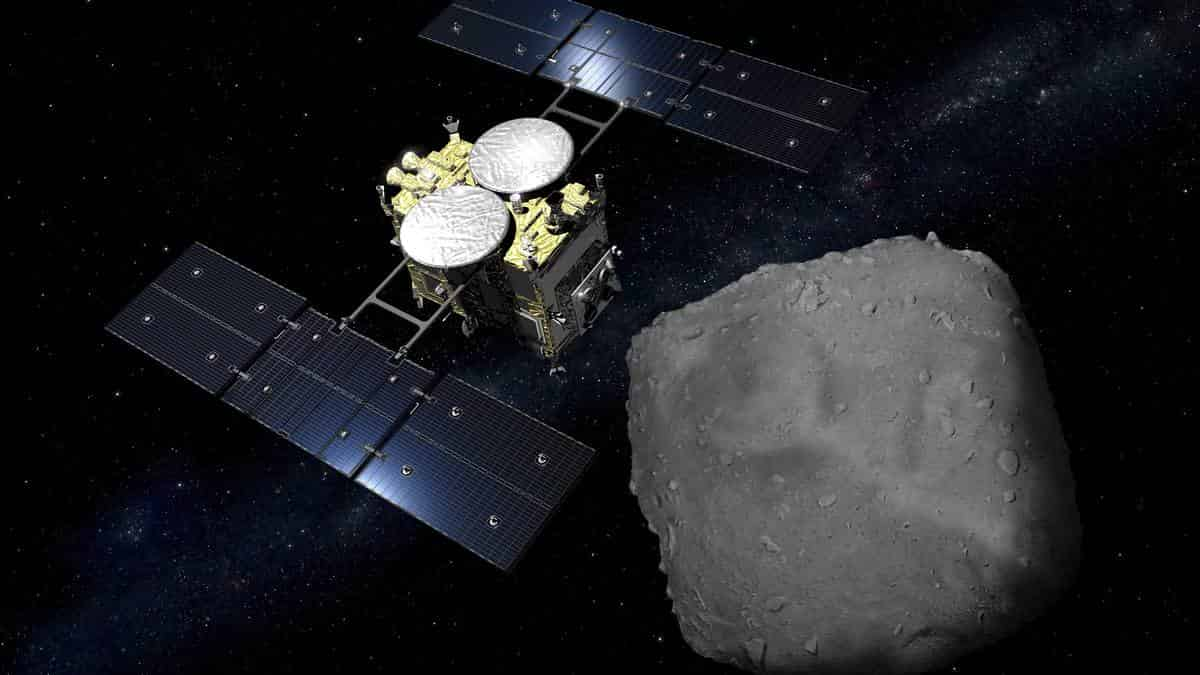Finally, asteroid dust to be available via Japan’s Hayabusa2

Consider it an exceptional conveyance: following six years in space, Japan’s Hayabusa2 test is going home, however just to drop off its uncommon space rock tests prior to beginning another mission.
The ice chest estimated test, dispatched in December 2014, has just excited researchers via arriving on and gathering material from a space rock somewhere in the range of 300 million kilometers (185 million miles) from Earth.
However, its work isn’t finished at this point, with researchers from Japan’s space organization JAXA now intending to broaden its main goal for over 10 years and focusing on two new space rocks.
Before that mission can start, Hayabusa2 needs to drop off its valuable examples from the space rock Ryugu, “monster royal residence” in Japanese.
Researchers are trusting the case will contain around 0.1 grams of material that will offer signs about what the close planetary system resembled at its introduction to the world some 4.6 billion years prior.
The examples could reveal insight into “how matter is spread around the close planetary system, why it exists on the space rock and how it is identified with Earth,” venture chief Yuichi Tsuda told correspondents in front of Sunday’s drop-off.
The material is in a case that will isolate from Hayabusa2 while it is approximately 220,000 kilometers above Earth and afterward fall into the southern Australian desert.
They were gathered during two urgent periods of the mission a year ago.
In the principal, Hayabusa2 landed on Ryugu to gather dust prior to terminating an “impactor” to work up immaculate material from underneath the surface. Months after the fact, it contacted down to gather extra examples.
“We might have the option to get substances that will give us signs to the introduction of a planet and the birthplace of life… I’m intrigued to see the substances,” mission director Makoto Yoshikawa told correspondents.
Shielded from daylight and radiation inside the case, the examples will be gathered, handled, at that point traveled to Japan.
A large portion of the material will be shared between JAXA, US space office NASA and other global associations, and the rest saved for future examination as advances are made in scientific innovation.
Two new space rock targets
Subsequent to dropping off its examples, Hayabusa2 will finish a progression of circles around the sun for around six years, recording information on residue in interplanetary space and noticing exoplanets.
It will at that point approach the first of its objective space rocks in July 2026.
The test won’t get that near the space rock named 2001 CC21, however researchers trust it will have the option to photo it as it finishes a “rapid swing-by”.
Getting so close could likewise help create information about how to secure Earth against space rock sway.
Hayabusa2 will at that point head towards its principle target, 1998 KY26, a ball-formed space rock with a breadth of only 30 meters. At the point when the test shows up at the space rock in July 2031, it will be roughly 300 million kilometers from Earth.
Furthermore, the objective postures huge new difficulties, not least since it is turning quickly, pivoting on its hub about like clockwork.
Hayabusa2 will notice and photo the space rock, yet it is probably not going to land and gather tests, as it likely won’t have enough fuel to restore them to Earth.
In any case, simply making it to the space rock will be an accomplishment, said Seiichiro Watanabe, a Hayabusa2 test venture researcher and educator of planetary science at Nagoya University.
“It resembles a competitor who scored two attempts at a Rugby World Cup game endeavoring to contend in the Olympics, 10 years subsequent to exchanging over to figure skating,” he told columnists.
“We had never expected that the Hayabusa2 would complete another mission… in any case, it’s an experimentally significant and interesting arrangement.”
The mission expansion accompanies hazards, including that Hayabusa2’s hardware will debase in profound space, yet it additionally offers an uncommon, nearly financially savvy approach to proceed with research.
The test is the replacement to JAXA’s first space rock traveler “Hayabusa”, which means hawk in Japanese.
That test brought back residue tests from a more modest, potato-molded space rock in 2010 following a seven-year odyssey, and was hailed as a logical victory.

